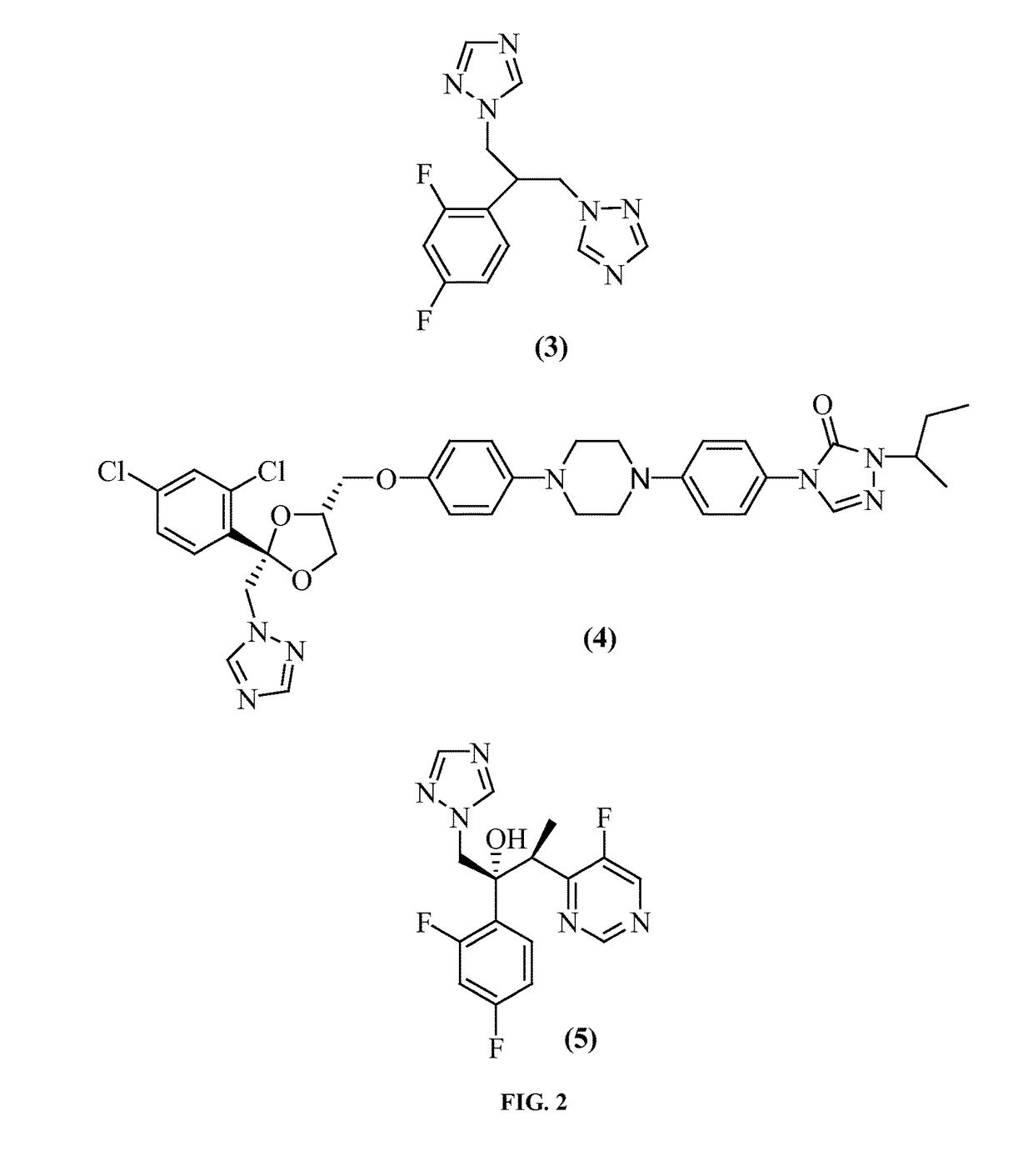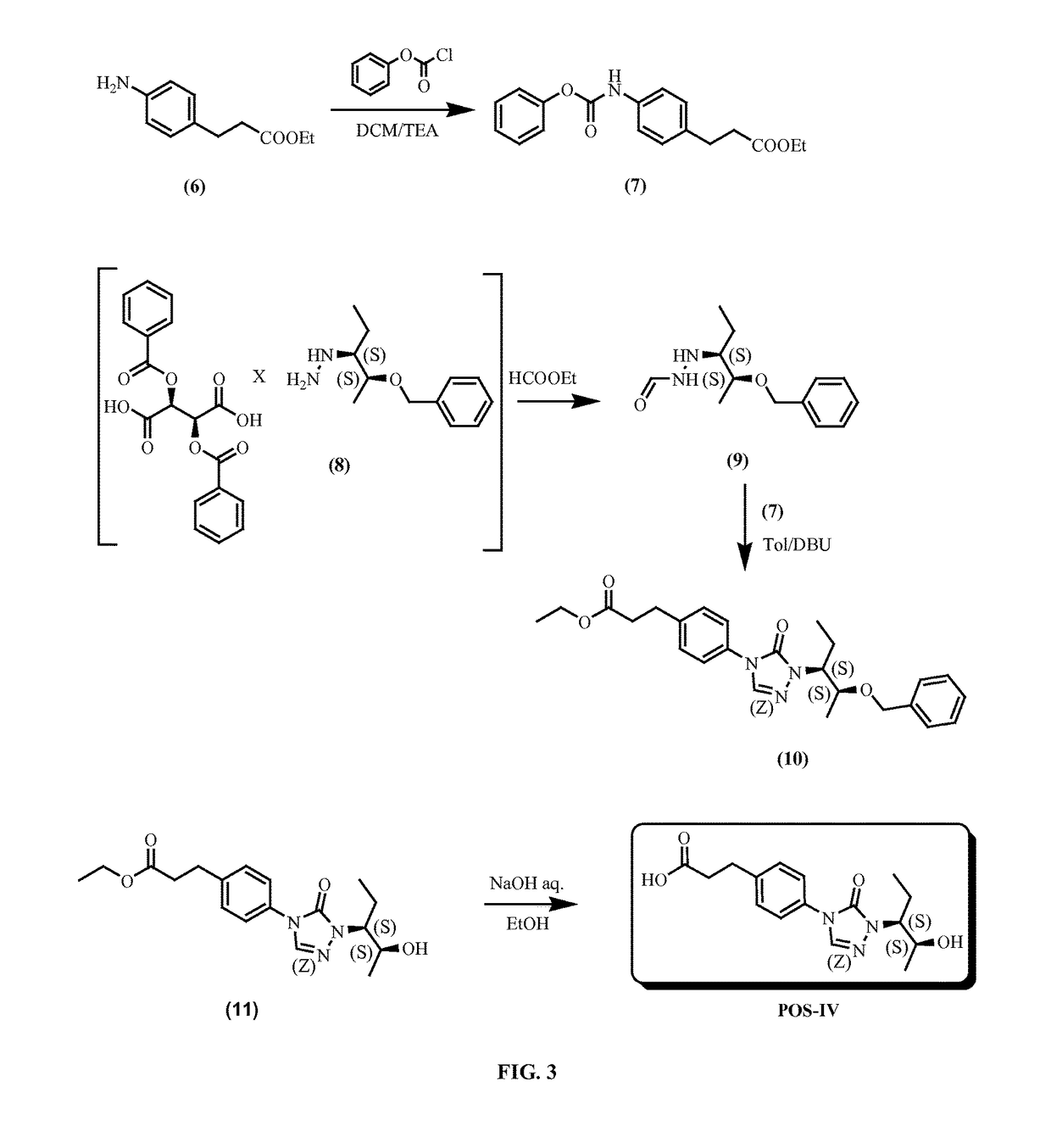Posaconazole immunoassays
a technology of immunoassay and posaconazole, which is applied in the field of triazole antifungal agent, can solve the problems of disproportionately increasing exposure when administered in divided doses, low bioavailability of posaconazole, and high morbidity and mortality
- Summary
- Abstract
- Description
- Claims
- Application Information
AI Technical Summary
Benefits of technology
Problems solved by technology
Method used
Image
Examples
example 1
Preparation of 3-(4-(1-((2S,3S)-2-hydroxypentan-3-yl)-5-oxo-1H-1,2,4-triazol-4(5H)-yl)phenyl)propanoic acid (POS-IV)
[0303]Step 1.
[0304]
[0305]To a solution of ethyl 3-(4-aminophenyl)propanoate (4 g, 20.7 mmol) in 40 mL of dichloromethane was added phenyl carbonochloridate (3.2 g, 20.7 mmol) at 0° C., followed by triethylamine (2.1 g, 20.7 mmol). The reaction solution was stirred at 0° C. for 1 h. The reaction solution was washed with brine, the organic layer was separated and dried over sodium sulfate, filtered and the filtrate was concentrated to give desired product (5.8 g, 91% yield) which was used in next step without purification.
[0306]Step 2
[0307]
[0308]1-((2S,3S)-2-(benzyloxy)pentan-3-yl)hydrazine (2S,3S)-2,3-bis(benzoyloxy)succinic acid salt (4 g, 7.0 mmol) suspended in 40 mL of ethyl formate, the mixture was heated at reflux for 4 h. The solution was diluted with ethyl acetate (100 mL) and washed with sodium bicarbonate aqueous solution and brine, the organic layer was separa...
example 2
Preparation Activated Hapten (Compound 12)
[0318]To dried DMF (250 μL) was added EDAC (6.59 mg, 0.0344 mmol) and dissolved. The EDAC solution was added to hapten compound (POS-IV) (9.17 mg, 0.0287 mmol) at room temperature and stirred for approximately 30 min. N-Hydroxysuccinimide (NHS) (4.12 mg, 0.0358 mmol) in DMF (50 μL) was added to the EDAC / hapten (POS-IV) solution. The mixture was stirred for approximately 2 hours at room temperature. Ester formation was monitored by TLC analysis. The activated hapten (12) was used in the next reaction. See FIG. 4.
example 3
Preparation Enzyme Conjugate (POS-IV G6PDH)
[0319]G6PDH (USB, Santa Clara, Calif.) suspended in ammonium sulfate was centrifuged for 15 min at 12,000 rpm. The resulting pellet was reconstituted with phosphate buffer (12.5 mM, pH 7.2). The solution was dialyzed for 2 days at 4° C. against phosphate buffer (12.5 mM, pH 7.2) with three times of buffer exchange. After dialysis, the enzyme solution was transferred to a reaction vial and the pH of the solution was adjusted to 8.7 with sodium bicarbonate buffer (0.4 M, pH 9.4) in the presence of glucose-6-phosphate (G6P, 4.5 mg / mg G6PDH) and NADH (9 mg / mg G6PDH) for the next reaction.
[0320]Activated hapten (12) was added in 5 to 10 μL quantities to a solution of glucose-6-phosphate dehydrogenase (G6PDH, pH 8.7) at room temperature. After the addition of each portion of solution of compound (12) a 2 μL aliquot was taken and was diluted 1:500 with enzyme buffer. A 3 μL aliquot of this diluted conjugation mixture was assayed for enzymatic acti...
PUM
| Property | Measurement | Unit |
|---|---|---|
| time | aaaaa | aaaaa |
| pH | aaaaa | aaaaa |
| fluorescence lifetime | aaaaa | aaaaa |
Abstract
Description
Claims
Application Information
 Login to View More
Login to View More - R&D
- Intellectual Property
- Life Sciences
- Materials
- Tech Scout
- Unparalleled Data Quality
- Higher Quality Content
- 60% Fewer Hallucinations
Browse by: Latest US Patents, China's latest patents, Technical Efficacy Thesaurus, Application Domain, Technology Topic, Popular Technical Reports.
© 2025 PatSnap. All rights reserved.Legal|Privacy policy|Modern Slavery Act Transparency Statement|Sitemap|About US| Contact US: help@patsnap.com



